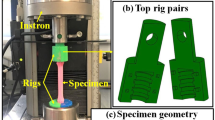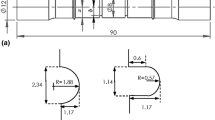Abstract
The present work focuses on the work hardening behavior of the AA2014-T6 billets deformed plastically between two flat cylindrical rigid dies under cold working condition. Three sets of billets of different aspect ratios (height (h) to the diameter (d)), namely h/d = 1, h/d = 0.75, and h/d = 0.5 were deformed to the different strain levels. Upon severe plastic deformation, the cylindrical billets will start cracking from the middle, and the crack will propagate to the surface. The hydrostatic stress and deviatoric stresses influence the failure of the billets resulting in poor ductility and distorting the shape of the billet. To analyze the effect of shear bands on the failure of the billet, maximum shear stress theory was applied. A detailed investigation has been carried out to study the influence of the tensile nature of the hoop stress, axial stress, and hydrostatic stresses. The critical paths for different aspect ratios of the deformed billets were plotted, and the failure of the specimen was well explained. The effect of anisotropy on the formability was studied by constituting the anisotropy factor with the ductile fracture models such as Gurson-Tvergaard-Needleman model and Lemaitre model. The influence of anisotropy on the void failure was studied, and critical damage was evaluated for different anisotropy ratios.
Similar content being viewed by others
References
Baskaran K, Narayanasamy R (2008) An experimental investigation on work hardening behaviour of elliptical shaped billets of aluminium during cold upsetting. Mater Des 29:1240–1265
Narayanasamy R, Pandey KS (1998) Some aspects of work hardening in sintered aluminium–iron composite preforms during cold axial forming. J Mater Process Technol 84:136–42
Inigoraj AJR, Narayanasamy R, Pandey KS (1998) Strain hardening behaviour of sintered aluminium–3.5 % alumina composite preforms during axial compression with and without annealing. J Mater Process Technol 84:143–148
Selvakumar N, Narayansamy R (2003) Phenomenon of strain hardening behaviour sintered aluminium preforms during cold axial forming. J Mater Process Technol 142:347–54
Vettivel SC, Selvakumar N, Vijay Ponraj P (2012) Mechanical behavior of sintered Cu-5%W nano powder composite. Procedia Eng 38:2874–2880
Baskaran K, Narayanasamy R (2008) Effect of various stress ratio parameters on cold upset forging of irregular shaped billets using graphite as lubricant under plane and triaxial stress state conditions. Mater Des 29:2089–2103
Baskaran K, Narayanasamy R (2008) Some aspects of barrelling in elliptical shaped billets of aluminium during cold upset forging with lubricant. Mater Des 29:638–661
Malayappan S, Esakkimuthu G (2006) Barrelling of aluminium solid cylinders during cold upsetting with differential frictional conditions at the faces. Int J Adv Manuf Technol. doi:10.1007/s00170-005-2503-6
Malayappan S, Narayanasamy R (2004) An experimental analysis of upset forging of aluminium cylindrical billets considering the dissimilar frictional conditions at flat die surfaces. Int J Adv Manuf Technol. doi:10.1007/s00170-003-1584-3
Fuh-Kuo C, Cheng-Jun C (2000) On the nonuniform deformation of the cylinder compression test. J Eng Mater Technol 122:192–197
Alves LM, Nielsen CV, Martins PAV (2011) Revisiting the fundamentals and capabilities of the stack compression test. Exp Mech 51:1565–1572
Song Y, Xiaolong X, Jie Z, Zhen Z (2007) Ductile fracture modeling of initiation and propagation in sheet-metal blanking processes. J Mater Process Technol 187–188:169–172
Li H, Fu FW, Lu J, Yang H (2011) Ductile fracture: experiments and computations. Int J Plast 27:147–180
Kim DJ, Kim BM (2002) Prediction of deformed configuration and ductile fracture for simple upsetting using an artificial neural network. Int J Adv Manuf Technol 19:336–342
Andrade Pires FM, Cesar-de-Sa JMA, Costa-Sousa L, Natal-Jorge RM (2003) Numerical modelling of ductile plastic damage in bulk metal forming. Int J Mech Sci 45:273–294
Gouveia BPPA, Rodrigues JMC, Martins PAF (2000) Ductile fracture in metalworking: experimental and theoretical research. J Mater Process Technol 101:52–63
Cockcroft MG, Latham DJ (1968) Ductility and the workability of metals. J Inst Met 96:33
Freudenthal FA (1950) The inelastic behavior of engineering materials & structures. John Wiley & Sons, New York
Brozzo P, Deluca B, Rendina R (1972) Proceedings of the Seventh Biennial Conference of the International Deep Drawing Research Group. Amsterdam, Netherlands
Abdel-Rahman M, El S (1995) Workability in forging of powder metallurgy compacts. J Mater Process Technol 54:97–102
Lemaitre J (1986) Local approach of fracture. Eng Fract Mech 25:523–537
Gurson AL (1977) Continuum theory of ductile rupture by void nucleation and growth—part I. Yield criteria and flow rules for porous ductile media. J Eng Mater Technol 99:2–15
Tvergaard V, Needleman A (1984) Analysis of the cup-cone fracture in a round tensile bar. Acta Metall 32:157–169
Xue L (2008) Constitutive modeling of void shearing effect in ductile fracture of porous materials. Eng Fract Mech 75:3343–3366
Hill R (1948) A theory of the yielding and plastic flow of anisotropic metals. Proc R Soc A 193:260–281
Landre J, Pertence A, Cetlin PR, Rodrigues JMC, Martins PAF (2003) On the utilization of ductile fracture criterion in cold forging. Finite Elem Anal Des 39:174–186
Erman T, Ozgur K (2003) Analysis of formability of metals, Master Thesis, Graduate School of Natural and applied sciences, The Middle East Technical University, Turkey
Sowerby R, O’Reilly I, Chandrasekaran N, Dung NL (1984) Materials testing for cold forging. ASME J Eng Mater Technol 106:101–106
Narayanasamy R, Ponalagusamy R (2005) Unpublished report on P/M forging part-I. National Institute of Technology, Tiruchirappalli
Doraivelu SM, Gegel HL, Gunasekara JS, Malas JC, Morgan JT (1984) A new yield function for compressible P/M materials. Int J Mech Sci 26:527–35
Narayanasamy R (2005) Unpublished report on P/M forging part-II. National Institute of Technology, Tiruchirappalli
Author information
Authors and Affiliations
Corresponding author
Rights and permissions
About this article
Cite this article
Krishna, C.H., Davidson, M.J. & Nagaraju, C. Investigation of work hardening behavior and failure analysis of billets due to biaxial stresses in simple upsetting process. Int J Adv Manuf Technol 79, 2017–2030 (2015). https://doi.org/10.1007/s00170-015-6948-y
Received:
Accepted:
Published:
Issue Date:
DOI: https://doi.org/10.1007/s00170-015-6948-y




